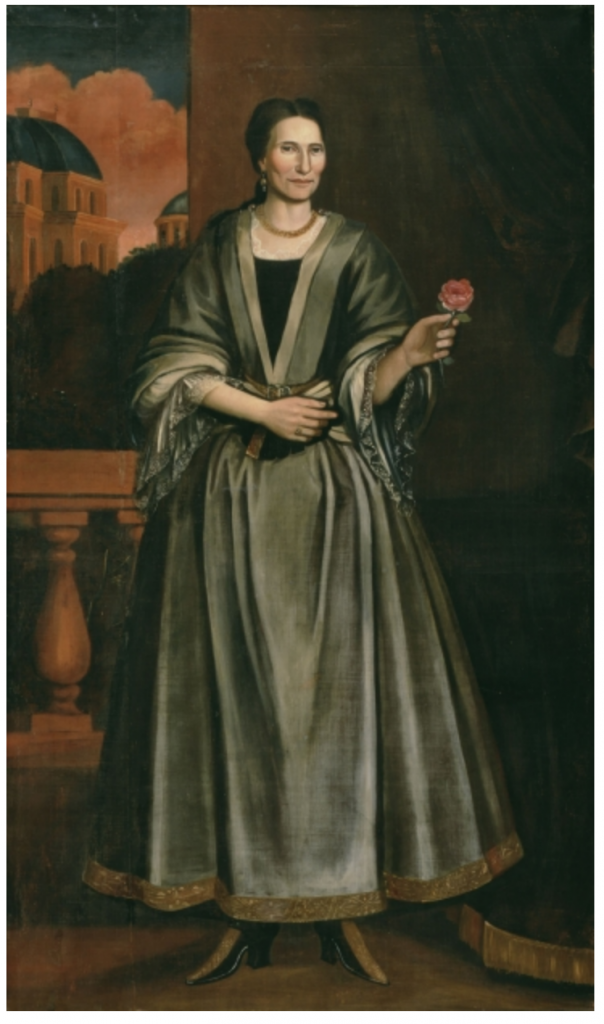In 1938, the Albany Institute of History and Art was bequeathed one of its more notable portraits, that of Ariaantje Coeymans, from 1723. When it was acquired, curator R. Loring Dunn wrote about it at length in the Times-Union. It tells us a lot about Ariaantje, and is worth printing here in its entirety:
The Albany Institute of History and Art has recently received, from the bequest of Miss Gertrude Watson, a large, full length portrait of Ariaantje Coeymans, attributed to Pieter Vanderlyn. The portrait is a valuable addition to the permanent collection of the Institute as it has both artistic and historic interest.
Pieter Vanderlyn was one of the earliest portrait painters of the Upper Hudson Valley, working in Kingston, Albany and Schenectady, between 1719 and 1723. His portraits are characterized by a bold and direct brush stroke, which has considerable charm, but not training enough to lend any great variety. The portrait of Ariaantje Coeymans was painted when she was well past middle life and shows her standing and in her out-stretched hand, she is holding a rose. Her elaborate gown is painted in that blueish-green color so typical of Vanderlyn. Through an opening in the background is seen a landscape with trees and sky and a large stone building. This opening is not sufficiently detailed to be called a window, but is so generalized that the position would indicate it as such, the walls having no thickness. The flesh color is good and the drawing of the face accurate enough to be called portrait, but where the artist woefully fails is in his treatment of the hands, which are stiff and much too large. The general effect of the whole is conventional and somewhat primitive. The story of Ariaantje Coeymans is one of the dramas of the Hudson valley. Helen Wilkinson Reynolds in her book entitled, “Dutch Houses in the Hudson Valley Before 1776,” has the following to say regarding the life of Ariaantje. “A few facts, only, constitute her known biography. When her father died (1714) Ariaantje was a woman in middle-life, unmarried, and it is to be supposed that she had lived repressed existence in the house of her aged father, longing for the things of a larger and fuller life; for immediately after she received her share of the estate [of] Barent Pieterse Coeymans she reacted, psychologically, in a marked way; she built a house, noteworthy for size and elegance; had her portrait painted life-size, in oil; and married. Ariaantje Coeymans came into her patrimony in 1716 when she was 45 years old. She built her house between 1716 and 1723, in which later year (when she was 51) her wedding took place under the new roof. She married David Verplanck, 23 years her junior, and the marriage was not happy. Her portrait shows Ariaantje to have been tall and angular, her face one with no claim to beauty, but her great frame arrayed in the most elegant of gowns and in her hand a rose, uplifted. What a revelation of the inner history of a woman’s life two centuries ago is made when the significant items are placed in sequence to each other. They disclose to us a mature and obscure spinster, eager for elegance and beauty and affection, and reaching out for all three but doomed to ultimate disappointment. Ariaantje’s house still stands; her portrait is treasured; but she, herself, died in 1743 in her handsome house, a lonely figure.”

Since Dunn wrote, it appears that someone decided the painter was not Pieter Vanderlyn, but instead Nehemiah Partridge. When that was determined, we cannot determine; perhaps it was the discovery that Vanderlyn’s painting career didn’t begin until about 1730 (contradicting Dunn’s account). The Institute now says this painting dates from 1718 or 1722-24. Ariaantje’s house in Coeymans still stands. Just a few years ago, the skull of a scalping victim was discovered during construction on the house’s basement (and it wasn’t the first time the skull had been found).

Leave a Reply